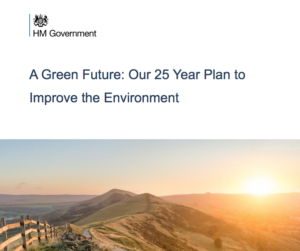
People Need Nature CEO Miles King writes about the Government’s new 25 Year Environment Plan:
“Michael Gove – the most energetic and intellectual Environment Secretary we have had for many years – has been busy. Fresh from his performances at the two big annual farming conferences of the year (which I will write about next week), Gove (perhaps with a push from the Prime Minister) has today published the long-awaited 25 Year Plan for the Environment.
Having seen a draft of the truly dreadful version created under his predecessor Andrea Leadsom, I’ve been looking forward to seeing what he has produced (from all accounts he’s had a very personal involvement in its creation) and the result is… 151 pages of verbiage.
Verbiage – an overabundance or superfluity of words, as in writing or speech
Why did it need to be so long and why did it take such a long time to produce?
It’s heartening, of course, to see the “intrinsic value” of nature repeatedly mentioned. Intrinsic in this sense means the value of nature for its own sake, not because it provides people with benefits – crucial though these benefits are.
The idea of Natural Capital is central to the plan – and it’s a controversial idea.
Some Natural Capitalists believe that everything in nature has a financial value – the danger with this view is that if something can be priced, it can be sold. Others recognise that some aspects of nature – beauty, or as a source of inspiration, cannot be valued economically, but are still of immeasurable value. The plan recognises this, without explaining how these “intangible” values will be protected.
There is a suggestion that if we all do our part, then the Environment will be protected – deciding whether to use a single-use coffee cup (with its non biodegradable plastic liner) or not, for example. But when two thirds of the UK is owned by 0.36% of the population, it’s clear that some individuals have a far bigger role to play than others.
One of the weakest elements of the plan – and it should really be the strongest – refers to “connecting people with the environment”. Apart from this being an uninspiring description of something so critical, there is no ambition or political drive here. And all the aspirations that are outlined fly in the face of reality.
Schools, for example, are being encouraged to create nature-friendly grounds, whilst clearly at cross-purposes, the Department for Education is telling them to build new school buildings on that same ground. And in the case of Toby Young’s Free Schools, these are being established in buildings with no grounds to green.
Can we expect nature-friendly window boxes provided by Defra? And while Defra may aspire to creating more urban green spaces for us to enjoy nature, the reality is that Local Authorities are being forced to sell off parks and greenspaces for housing, to offset cuts from central Government funding.
The Public Forest Estate (that is land owned or leased by the Forestry Commission in England) continues to receive special protection within the Plan. This probably emanates from the 2011 forestry sell-off debacle – which ultimately led to Environment Secretary Caroline Spelman being publicly humiliated by former PM David Cameron (remember him?) in the House of Commons. Other public land continues to be sold off though – Ministry of Defence land (such as the Nightingale and Meadow haven at Lodge Hill Kent) is being sold off for housing, as are Prisons, Public Parks and even NHS land. While Forests are safe, the public estate is being quietly disposed of – with big implications for the environment.
We know how keen Michael Gove is on Beavers, but it looks like he did not get this all his own way – the section on Natural Flood Management mentions “building small-scale woody dams” but doesn’t suggest that the reintroduction of beavers is the best way of building them. Why, I wonder, pay people to build woody dams, when Beavers will do it for free?
A commitment to produce a Strategy for Nature – to replace the now aging (and mostly undelivered) Biodiversity 2020 strategy, does feel a bit like the can has been kicked down the road, yet again.
And although it’s welcome to see a target of 500,000ha of new wildlife habitat being created, why is there no commitment to protect the existing and still threatened areas of high quality wildlife habitat?
We really need the series of Sites of Special Scientific Interest, (started in 1949), to be completed – before what’s left has gone.
Another challenge will be how to prevent new wildlife habitat, created under a 10-year- scheme such as countryside stewardship, being converted back into farmland again when that scheme ends.
The plan is full of good intentions and these need to be recognised and encouraged. But what we also need to remember, is that under this and the previous Government, funding for the Environment Department Defra, and its agencies, including Natural England and the Environment Agency, have been cut, cut and cut again. Defra budgets have been cut by nearly half since 2010 and expert staff have been lost, both within the department and across its agencies.
Environmentalists often bemoan the short-termism of five year Governments. The environment operates on a range of time-scales – many are far longer than five years. Equally, the danger of a 25 year plan is that aspirations can be made that are risk-free – because this Government will not be around in 25 years time to be held to account for their failures, or feted for their successes. After all, if the Government had announced the publication of a 200 million year environment plan, they could commit to the complete eradication of marine plastic, because by then it will have been converted, by geological processes, into a thin layer of oil.
I’ve seen a lot of these documents over the past 30 years, and this is definitely not the worst. But as with all the others, it will be judged by how much of it is actually delivered.
What we need is more herbage, and less verbiage!”
This article originally appeared in Miles King’s new column for Lush Times.

Comments are closed.